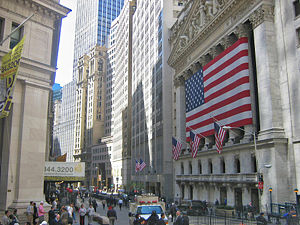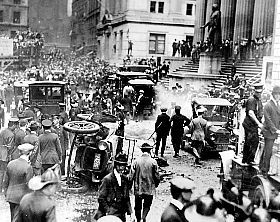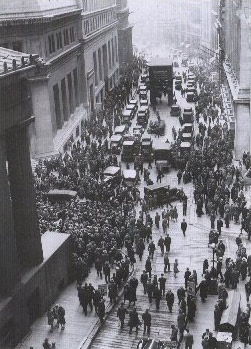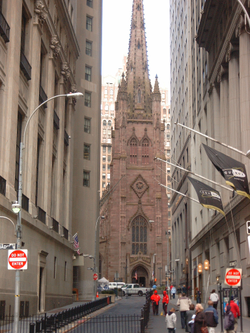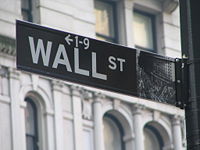Wall Street
2008/9 Schools Wikipedia Selection. Related subjects: Business; North American Geography
Wall Street is a thoroughfare in lower Manhattan, New York City, United States of America. It runs east from Broadway downhill to South Street on the East River, through the historical centre of the Financial District. Wall Street was the first permanent home of the New York Stock Exchange, and over time Wall Street became the name of the surrounding geographic neighbourhood. Wall Street is also shorthand (or a metonym) for "influential financial interests" in the U.S. as well as for the financial industry in the New York City area.
Several major U.S. stock and other exchanges remain headquartered on Wall Street and in the Financial District, including the NYSE, NASDAQ, AMEX, NYMEX, and NYBOT. Many New York-based financial firms are no longer headquartered on Wall Street, but are in midtown Manhattan, the outer boroughs of the city, Long Island, Westchester County, Fairfield County, Connecticut, or New Jersey.
History
Despite widely held beliefs that Wall Street is based on the existence of a wall, maps of New Amsterdam show two different names for this street, and with one name 'cingel,' an earthen wall is indeed indicated. However, the name 'De Waal Straat' (see map) refers not to a wall, but to an important group of people that helped establish New Amsterdam: the Walloons. By 1630 the total population of New Netherland was about 300, many being French speaking Walloons. It is estimated about 270 lived in the area surrounding Fort Amsterdam, primarily working as farmers. The Dutch word for Walloon is Waal.
During the 17th century, Wall Street formed the northern boundary of the New Amsterdam settlement. In the 1640s basic picket and plank fences denoted plots and residences in the colony. Later, on behalf of the Dutch West India Company, Peter Stuyvesant, in part using African slaves, led the Dutch in the construction of a stronger stockade. By the time war had developed with the English, a strengthened 12-foot (4 m) wall of timber and earth was created by 1653 fortified by palisades. The wall was created, and strengthened over time, as a defense against attack from various Indian tribes, New England colonists, and the British. In 1685 surveyors laid out Wall Street along the lines of the original stockade. The wall was dismantled by the British in 1699. And while the original name referred to the Walloons, the French speaking Belgians that helped populate this settlements in the beginning, the name was now easily taken to refer to the wall that once was here.
In the late 18th century, there was a buttonwood tree at the foot of Wall Street under which traders and speculators would gather to trade informally. In 1792, the traders formalized their association with the Buttonwood Agreement. This was the origin of the New York Stock Exchange.
In 1889, the original stock report, Customers' Afternoon Letter, became the The Wall Street Journal, named in reference to the actual street, it is now an influential international daily business newspaper published in New York City. For many years, it had the widest circulation of any newspaper in the United States, although it is currently second to USA Today. It is owned by Dow Jones & Company.
Decline and revitalization
The Manhattan Financial District is one of the largest business districts in the United States, and second in New York City only to Midtown. In the late 19th and early 20th centuries, the corporate culture of New York was a primary centre for the construction of skyscrapers (rivaled only by Chicago). The Financial District, even today, actually makes up a distinct skyline of its own, separate from but not soaring to quite the same heights as its midtown counterpart a few miles to the north.
Built in 1914, 23 Wall Street was known as the " House of Morgan" and for decades the bank's headquarters was the most important address in American finance. At noon, on September 16, 1920, a bomb exploded in front of the bank, killing 38 and injuring 300. Shortly before the bomb went off a warning note was placed in a mailbox at the corner of Cedar Street and Broadway. While theories abound about who was behind the Wall Street bombing and why they did it, after twenty years investigating the matter, the FBI rendered the file inactive in 1940 without ever finding the perpetrators.
1929 brought the "Great Crash" of the stock market, ushering in the Great Depression. During this era, new development of the Financial District had stagnated. The construction of the World Trade Centre was one of the few major projects undertaken during the last three quarters of the 20th century and, financially, it was not originally, as successful as planned. Some point to the fact that it was actually a government-funded project, constructed by the Port Authority of New York and New Jersey with the intention of spurring economic development in downtown. All the tools necessary to international trade were to be housed in the complex. However, at the beginning much of the space remained vacant.
Nonetheless, some large and powerful firms did purchase space in the World Trade Center. Further, it attracted other powerful businesses to the immediate neighborhood. In some ways, it could be argued that the World Trade Center changed the nexus of the Financial District from Wall Street to the Trade Center complex. When the World Trade Centre was destroyed in the September 11, 2001 attacks, it left somewhat of an architectural void as new developments since the 1970s had played off the complex aesthetically. The attacks, however, contributed to the loss of business on Wall Street, due to temporary-to-permanent relocation to New Jersey and further decentralization with establishments transferred to cities like Chicago and Boston.
Wall Street itself and the Financial District as a whole are crowded with highrises by any standard of measure. Further, the loss of the World Trade Center has actually spurred development in the Financial District on a scale that hasn't been seen in decades. This is in part due to tax incentives provided by the federal, state and local governments to encourage development. A new World Trade Centre complex, centered on Daniel Liebeskind's Memory Foundations plan, is in the early stages of development and one building has already been replaced. The centerpiece to this plan is the 1,776-foot (541 m) tall Freedom Tower. New residential buildings are already sprouting up, and buildings that were previously office space are being converted to residential units, also benefiting from the tax incentives. Better access to the Financial District is planned in the form of a new commuter rail station and a new downtown transportation centre centered on Fulton Street.
Wall Street today
To say that a corporation is a "Wall Street company" today does not necessarily mean that the company is physically located on Wall Street. It more likely means that the firm deals with financial services; such a firm could be headquartered in many places across the globe. Today, much of Wall Street's workforce tends to be made up of professionals working in the fields of law or finance who work for medium- to large-sized corporations. Many of the nearby businesses are local companies and chain stores that cater to the tastes of professionals and to the needs of the workforce. Most people who work in the Financial District commute from suburbs in Long Island, Connecticut, Pennsylvania, New Jersey, and the lower Hudson Valley.
Wall Street's culture is often criticized as being rigid. This is a decades-old stereotype stemming from the Wall Street's establishment's protection of their interests, and the link to the WASP establishment. More recent criticism has centered on structural problems and lack of a desire to change well-established habits. Wall Street's establishment resists government oversight and regulation. At the same time, New York City has a reputation as a very bureaucratic city, which makes entry into the neighbourhood difficult or even impossible for middle class entrepreneurs.
Since the founding of the Federal Reserve banking system, the Federal Reserve Bank of New York in the Financial District has been the point where monetary policy in the United States is implemented (although it is decided in Washington, D.C. by the Federal Reserve Bank's Board of Governors). As such, New York State is today unique in that it is the only state that constitutes its own district of the Federal Reserve Banking system. This is perhaps partly owed to population distribution in the United States of the time, however. Until the 1960s, New York was the most populated state in the U.S.; it now ranks third, behind California and Texas. The NY Federal Reserve's president is the only regional Bank president with a permanent vote and is traditionally selected as its vice chairman. The bank has a gold vault 80 feet (25 m) beneath the street. This depository is the largest in the world, larger even than Fort Knox.
Buildings
Wall Street's architecture is generally rooted in the Gilded Age, though there are also some art deco influences in the neighbourhood. Landmark buildings on Wall Street include Federal Hall, 14 Wall Street ( Bankers Trust Company Building), 40 Wall Street (The Trump Building), and the New York Stock Exchange at the corner of Broad Street.
Personalities
Over the years, certain persons associated with Wall Street have become famous, even legendary. Although their reputations are usually limited to members of the stock brokerage and banking communities, several have gained national and international fame. Some earned their fame for their investment strategies, financing, reporting, legal or regulatory skills, while others are remembered for their greed. One of the most iconic representations of the market prosperity is the Charging Bull sculpture, by Arturo Di Modica. Representing the bull market economy, the sculpture was originally placed in front of the New York Stock Exchange, and subsequently moved to its current location in Bowling Green.
Cultural influence
Wall Street vs. Main Street
As a figure of speech contrasted to " Main Street," the term "Wall Street" can refer to big business interests against those of small business and the working or middle class. It is sometimes used more specifically to refer to research analysts, shareholders, and financial institutions such as investment banks. The idea of "Main Street" conjures up images of locally owned businesses and banks. While the phrase "Wall Street" is commonly used interchangeably with the phrase " Corporate America", it is also sometimes used in contrast to distinguish between the interests, culture, and lifestyles of investment banks and those of Fortune 500 industrial or service corporations.
Perceptions
The older skyscrapers often were built with elaborate facades; such elaborate aesthetics haven't been common in corporate architecture for decades. The World Trade Centre, built in the 1970s, was very plain and utilitarian in comparison (the Twin Towers were often criticized as looking like two big boxes, despite their impressive height).
Wall Street, more than anything, represents financial and economic power. To Americans, Wall Street can sometimes represent elitism and power politics and cut-throat capitalism, but it also stirs feelings of pride about the market economy. Wall Street became the symbol of a country and economic system that many Americans see as having developed not through colonialism and plunder, but through trade, capitalism, and innovation. (Fraser 2005)
In literature and popular culture
Herman Melville's classic short story Bartleby the Scrivener is subtitled A Story of Wall Street and provides an excellent portrayal of a kind and wealthy lawyer's struggle to reason with that which is unreasonable as he is pushed beyond his comfort zone to "feel" something real for humanity.
In William Faulkner's novel The Sound and the Fury, Jason Compson hits on other perceptions of Wall Street: after finding some of his stocks are doing poorly, he blames the Jews.
The film Wall Street exemplifies many popular conceptions of Wall Street, being a tale of shady corporate dealings and insider trading.
In the film National Treasure a clue to finding the Templar Treasure leads Benjamin Franklin Gates ( Nicolas Cage), Dr. Abigail Chase ( Diane Kruger), Riley Poole ( Justin Bartha) and Patrick Henry Gates ( Jon Voight) to Wall Street, and more spefically, to the Trinity Church.
Transport
Because Wall Street was historically a commuter destination, it has seen much transportation infrastructure developed with it in mind. Today, the New York City subway has three stations under Wall Street itself:
- Wall Street (IRT Broadway-Seventh Avenue Line) at Wall Street & William Street
- Wall Street (IRT Lexington Avenue Line) at Wall Street & Broadway
- Broad Street (BMT Nassau Street Line) at Wall Street & Broad Street
Similar institutions
The financial clout of Wall Street is most rivaled only by:
- London's "Square Mile," the financial heart of the United Kingdom.
- Tokyo's financial institutions
- The banks of Switzerland, which offer a haven of secrecy and are collectively referenced as "the Gnomes of Zurich."
In North America, the nearest rivals are:
- Commodity exchange markets in Chicago, Illinois, USA, most notably the Chicago Mercantile Exchange (the CME is listed on the New York Stock Exchange).
- Montgomery Street in San Francisco, also known as the "Wall Street of the West".
- Sand Hill Road in Silicon Valley, the heart of the venture capital industry. Historically, the Pacific Stock Exchange in San Francisco was the major exchange on the West Coast, although it has been replaced entirely by electronic trading.
- Bay Street in Toronto, Ontario, Canada (Canada's financial heart).
